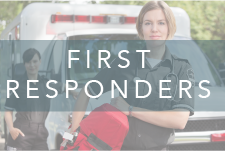“Trauma” is a term that often brings up certain images, with natural disasters, domestic or sexual violence, and physical injury all being common associations. However, First Responder trauma’s definition is incredibly far-reaching and affects an individual in a number of ways. Being aware of the different forms trauma can take is essential for identifying and addressing the situation before destructive or unhealthy coping strategies take hold.
First responders, being on the front lines each and every day, are also at the greatest risk for exposure to various kinds of trauma that others may not be aware of. First Responder Trauma is more than just being present at a disastrous event — it also includes helping others who have suffered through it and seeing the aftermath of the situation.
Different Forms of First Responder Trauma
Trauma can mean a wide variety of things, depending on the situation and people involved. For some, trauma can be experiencing a natural disaster or another form of mass destruction. Floods, fires, and more can all result in great loss, both in the loss of life as well as the loss of personal and sentimental belongings.

First responders are also prone to traumatic exposure to deadly force. Some may be on the front lines and forced to face an individual wielding a deadly intention, or be forced to use deadly force on another themselves — each of which can have a major impact on a person’s mental health. Domestic violence, and having to intervene in domestic circumstances, can also have a similar effect on an individual and reinforce a perception of violence in one’s worldview.
Others may experience trauma as an intimacy gone wrong, such as in violent or abusive relationships, unwanted sexual advances, or verbal/emotional manipulation and abuse. These experiences can reform how an individual sees the world around them, while also compromising their sense of self-worth.
Lastly, an individual does not necessarily have to be on the front lines of a harrowing event to experience the trauma that it has caused. Arriving as medical support on the scene of a disaster and seeing injury, hearing about abuse cases and disastrous events, or seeing others in a panicked state, can all fundamentally shape one’s worldview. These events can all carry their own traumatic impact.
The Effects of Trauma’s Various Forms
Regardless of whether it was experienced first-hand or vicariously through other victims, trauma fundamentally affects an individual’s health. Whether a person is suffering from flashbacks, nightmares, or having their mind filled with harrowing images from vicarious trauma, stories, and recollections, each of these traumas is very real. All of these factors can create an incredibly difficult situation for those asked to repeatedly return to the front lines and protect others. Some other symptoms of trauma may include:
Fatigue
Impaired decision-making
Lack of concentration
Anger and frustration
Mood swings
Substance use
Invasive thoughts or images
Hypervigilance
Social avoidance
Insomnia
Irrational fear
Anxiety
Depression
Panic
Guilt
These are just some of the ways trauma can impact a person’s daily life. Those who are commonly put in traumatic situations must be aware of these signs, as well as the impact trauma may have on future events.
How Trauma Affects a First Responder in the Field
There are many different ways trauma can change how one operates in the field, whether they are responding to a routine call or the heat of a tense situation.
Experiencing trauma of any kind can reform how an individual perceives the world around them, changing how one approaches otherwise routine events. First responders who have experienced high-stakes and dangerous situations may change how they approach future situations based on these traumatic experiences.
Being involved in a gun-related situation can cause an individual to not just be wary of this potential circumstance, but they may also be expecting violence as a regular part of the job. This can ultimately cause them to perceive normal things like routine traffic stops as dangerous, violent situations. Being prepared to defend one’s life at all times is an exhausting mental state to occupy. It both hinders a person’s ability to make decisions in the field and takes a huge toll on their mental health, as the brain is forced into a constant state of survival.
Those who have experienced trauma may also begin making riskier behaviors in the field or exercise a decreased sense of their own safety. Depression, anxiety, panic, and an altered worldview can prompt an individual to take these increased risks, putting themselves at an even greater chance for repeat exposure to trauma and complicate incredibly delicate situations.
Understanding the various forms that trauma can take is essential in taking the first step to deconstructing the flawed idea that just “getting over” trauma is possible by willpower alone. Trauma is something that needs to be addressed not just for the implications it has on an individual’s mental health, but also to help prevent a cycle of trauma from continuing to negatively impact the first responders who are regularly exposed to it.









